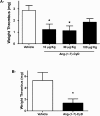An orally active formulation of angiotensin-(1-7) produces an antithrombotic effect
- PMID: 21789389
- PMCID: PMC3109384
- DOI: 10.1590/s1807-59322011000500021
An orally active formulation of angiotensin-(1-7) produces an antithrombotic effect
Abstract
Introduction and objective: The heptapeptide angiotensin-(1-7) is a component of the renin-angiotensin system, which promotes many beneficial cardiovascular effects, including antithrombotic activity. We have recently shown that the antithrombotic effect of angiotensin-(1-7) involves receptor Mas-mediated NO-release from platelets. Here, we describe an orally active formulation based on angiotensin-(1-7) inclusion in cyclodextrin [Ang-(1-7)- CyD] as an antithrombotic agent. Cyclodextrins are pharmaceutical tools that are used to enhance drug stability, absorption across biological barriers and gastric protection.
Method: To test the antithrombotic effect of Ang-(1-7)-CyD, thrombus formation was induced in the abdominal vena cava of spontaneously hypertensive rats that were pretreated either acutely or chronically with Ang-(1-7)-CyD. Male Mas-knockout and wild-type mice were used to verify the role of the Mas receptor on the effect of Ang-(1-7)-CyD.
Results: Acute or chronic oral treatment with Ang-(1-7)-CyD promoted an antithrombotic effect (measured by thrombus weight; all values are, respectively, untreated vs. treated animals) in spontaneously hypertensive rats (acute: 2.86 ± 0.43 mg vs. 1.14 ± 0.40 mg; chronic: 4.27 ± 1.03 mg vs. 1.39 ± 0.68 mg). This effect was abolished in Mas-knockout mice (thrombus weight in Mas wild-type: 0.76 ± 0.10 mg vs. 0.37 ± 0.02 mg; thrombus weight in Mas-knockout: 0.96 ± 0.11 mg vs. 0.87 ± 0.14 mg). Furthermore, the antithrombotic effect of Ang-(1-7)-CyD was associated with an increase in the plasma level of Angiotensin-(1-7).
Conclusion: These results show for the first time that the oral formulation Ang-(1-7)-CyD has biological activity and produces a Mas-dependent antithrombotic effect.
Figures


References
-
- Willoughby S, Holmes A, Loscalzo J. Platelets and cardiovascular disease. Eur J Cardiovasc Nurs. 2002;1:273–88. 10.1016/S1474-5151(02)00038-5 - DOI - PubMed
-
- Lip GY. Hypertension, platelets, and the endothelium: the "thrombotic paradox" of hypertension (or "Birmingham paradox") revisited. Hypertension. 2003;41:199–200. 10.1161/01.HYP.0000049761.98155.7B - DOI - PubMed
-
- Kucharewicz I, Pawlak R, Matys T, Chabielska E, Buczko W. Angiotensin-(1-7): an active member of the renin-angiotensin system. J Physiol Pharmacol. 2002;53:533–40. - PubMed
-
- HOPE Investigators. Effects of ramipril on cardiovascular and microvascular outcomes in people with diabetes mellitus: Results of the HOPE study and MICRO-HOPE substudy. Heart Outcomes Prevention Evaluation Study Investigators. Lancet. 2000;355:253–9. 10.1016/S0140-6736(99)12323-7 - DOI - PubMed
-
- Dahlof B, Devereux RB, Kjeldsen SE, Julius S, Beevers G, de Faire U, et al. Cardiovascular morbidity and mortality in the Losartan Intervention For Endpoint reduction in hypertension study (LIFE): A randomised trial against atenolol. Lancet. 2002;359:995–1003. 10.1016/S0140-6736(02)08089-3 - DOI - PubMed
MeSH terms
Substances
LinkOut - more resources
Full Text Sources
Other Literature Sources
Medical
Miscellaneous

